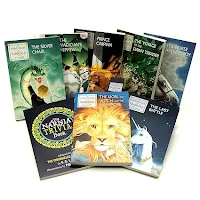The Chronicles of Narnia and why your kids will love these books

The Chronicles of Narnia is a beloved series of seven fantasy novels written by C.S. Lewis. These enchanting tales transport readers to a magical land filled with talking animals, mythical creatures, and epic adventures. Here's a brief overview of the books:
1. The Lion, the Witch, and the Wardrobe (1950)
Four siblings, the Pevensie children, discover a magical wardrobe that transports them to the enchanted land of Narnia. There, they find themselves in the midst of a perpetual winter caused by the evil White Witch. With the help of the noble lion Aslan, the children fight to free Narnia from her tyrannical rule.
2. Prince Caspian (1951)
The Pevensie children return to Narnia and find the land under the oppressive rule of the Telmarines. They join forces with Prince Caspian, the rightful heir to the Narnian throne, to overthrow the Telmarines and restore Narnia's glory.
3. The Voyage of the Dawn Treader (1952)
The Pevensie children and their cousin Eustace embark on a perilous sea voyage aboard the Dawn Treader. They encounter mythical creatures, face treacherous seas, and discover ancient secrets hidden on the mysterious islands of the Eastern Seas.
4. The Silver Chair (1953)
Edmund and Eustace are kidnapped and taken to the gloomy land of Underland. There, they meet a lost prince and embark on a dangerous quest to rescue him and uncover the secrets of Underland's dark ruler.
5. The Horse and His Boy (1954)
A human boy named Shasta and a talking horse named Bree flee their oppressive lives and embark on a journey through Narnia. They encounter danger, friendship, and the true meaning of courage.
6. The Magician's Nephew (1955)
This prequel to the series reveals the creation of Narnia. The young boys Digory and Polly are transported to a magical world where they meet the powerful magician Uncle Andrew and witness the birth of the magical wardrobe that connects our world to Narnia.
7. The Last Battle (1956)
The Pevensie children return to Narnia for the final time. They face the evil Calormenes and their leader, the Tistel Tashi, who seeks to destroy Narnia. The children must fight for the survival of Narnia and experience the ultimate fate of the magical land.
Why Read the Narnia Series?
The Chronicles of Narnia, penned by C.S. Lewis, offer a timeless adventure that captivates readers of all ages. These enchanting tales transport you to a magical land filled with talking animals, mythical creatures, and epic quests.Key reasons to embark on this literary journey:
- Timeless Themes: The series explores profound themes such as good versus evil, courage, sacrifice, and the power of love. These universal themes resonate with readers of all backgrounds.
- Imaginative Worldbuilding: Lewis's vivid descriptions bring Narnia to life, creating a richly detailed and immersive world that will transport you to another realm.
- Memorable Characters: The Pevensie children, Aslan the Lion, and other iconic characters are unforgettable and inspire readers to believe in the power of friendship, loyalty, and hope.
- A Sense of Wonder: The Narnia series evokes a sense of wonder and childlike curiosity, reminding us of the magic and beauty that exists in the world.
- A Classic for All Ages: Whether you're a young reader or an adult seeking a nostalgic escape, the Chronicles of Narnia offer something for everyone.
If you're looking for a captivating adventure that will stay with you long after the final page, the Narnia series is a must-read.
Is there a reading order of the books?
While the original publication order is often recommended for a complete understanding of the series, some readers prefer to start with the first chronological story, The Magician's Nephew, to delve into the origins of Narnia before experiencing the adventures of the Pevensie children.The Switch to Chronological Order
For many years, both orders were in print. American editions used publication order while British editions were numbered chronologically.
Chronological order became the worldwide standard after HarperCollins took over the publishing in 1994.
So, which book should I read first?
The Lion, the Witch and the Wardrobe, the first book to be written and published, is generally considered the best introduction to Narnia by scholars and fans alike.
“Most scholars disagree with [the decision to re-number the books] and find it the least faithful to Lewis’s deepest intentions,” says Dr. Paul F. Ford, author of Companion to Narnia.
On the official website of C. S. Lewis, Dr. Charlie W. Starr claims that “Lewis scholars almost universally agree” that the original published order is superior. He suggests that The Lion, the Witch and the Wardrobe is more initially captivating than The Magician’s Nephew, that certain lines in Lion do not make sense when the book is not read first,and that Nephew has greater mythic power when read as a prequel.
Why were the books re-numbered chronologically?
Initially, HarperCollins included this explanation in the books:
The HarperCollins editions of The Chronicles of Narnia have been re-numbered in compliance with the original wishes of the author, C. S. Lewis.
In later editions, the explanation was revised to:
Although The Magician’s Nephew was written several years after C. S. Lewis first began The Chronicles of Narnia, he wanted it to be read as the first book in the series. HarperCollins is happy to present these books in the order in which Professor Lewis preferred.
What did C. S. Lewis actually say?
In 1957, an 11-year-old boy named Lawrence Krieg was preparing to read the Narnia books for a second time. Lawrence wondered if he should re-read them chronologically, but his mother felt he should stick with the original published order. So, Lawrence wrote a letter to the author and received this response:
“I think I agree with your order for reading the books more than with your mother’s. The series was not planned beforehand as she thinks. When I wrote The Lion I did not know I was going to write any more. Then I wrote P. Caspian as a sequel and still didn’t think there would be any more, and when I had done The Voyage I felt quite sure it would be the last. But I found as I was wrong. So perhaps it does not matter very much in which order anyone read them.” - C. S. Lewis, 4/23/57
This letter is cited by readers on both sides of the controversial decision to re-number the books. Proponents see this as clear proof Lewis wanted the books read in chronological order. Opponents point out that Lewis suggested the order “does not matter very much” in the same letter and he could have re-numbered the books himself if he really wanted to.
Douglas Gresham, stepson of C.S. Lewis (“Jack”), said:
“[HarperCollins] asked, ‘What order do you think we ought to do them in?’ And I said, ‘Well … I actually asked Jack himself what order he preferred and thought they should be read in. And he said he thought they should be read in the order of Narnian chronology.’ So I said, ‘Why don’t you go with what Jack himself wanted?’ So, it’s my fault basically—the order of Narnian chronology. And I’m not the least bit ashamed of it.” - Douglas Gresham
Here's an alternative reading order based on chronology:
- The Magician's Nephew (1955)
- The Lion, the Witch, and the Wardrobe (1950)
- Prince Caspian (1951)
- The Voyage of the Dawn Treader (1952)
- The Silver Chair (1953)
- The Horse and His Boy (1954)
- The Last Battle (1956)
Ultimately, the best reading order is the one that you find most enjoyable. Experiment with different sequences and see which one resonates with you the most.
 C.S. Lewis: The Man Behind Narnia
C.S. Lewis: The Man Behind Narnia Clive Staples Lewis, often referred to as C.S. Lewis, was a renowned English writer, academic, and Christian apologist. Born in Belfast, Northern Ireland, in 1898, Lewis experienced a tumultuous childhood marked by the loss of his mother and a brother. His early experiences, combined with his deep faith, would later shape his writing.
Lewis's academic pursuits led him to Oxford University, where he became a prominent figure in literary circles. His early works focused on medieval literature and philosophy. However, it was his fascination with mythology and fairy tales that inspired him to create the magical world of Narnia.
Motivated by a desire to write stories that would appeal to both children and adults, Lewis began work on The Chronicles of Narnia. Drawing inspiration from Christian allegory, Norse mythology, and classic fairy tales, he crafted a series that explored themes of good versus evil, courage, sacrifice, and the power of love. Lewis's goal was to create a world where readers could encounter timeless truths and experience the joy of adventure.
A final conclusion: Would these books be recommended to Christian children?
Yes, the Chronicles of Narnia are often recommended to Christian children. While the series is not overtly religious, it contains strong Christian themes and symbolism that can resonate with young believers.Here are a few reasons why the Narnia series might be appealing to Christian children:
- Christian Allegory: Many of the events and characters in Narnia can be seen as allegories for Christian concepts, such as the sacrifice of Aslan representing the crucifixion of Jesus.
- Moral Lessons: The series teaches important moral lessons about good and evil, courage, forgiveness, and the importance of faith.
- Positive Role Models: The characters of Aslan, the Pevensie children, and other positive figures in Narnia can serve as inspiring role models for young readers.
- A Sense of Hope: The series offers a message of hope and redemption, which can be comforting and uplifting for young Christians.
However, it's important to note that the interpretation of the Narnia series is subjective, and individual experiences may vary. Some may find the Christian symbolism more explicit than others. Ultimately, the decision of whether to recommend the Narnia series to Christian children should be made based on individual values and beliefs.
This material is a compilation of some research I made on the Narnia Series, some of the information I got from Narnia Web site, to whom I would like to thank for their great effort in promoting and furthering the development of Narnia movies (you can read more about it on their website, of course).
Bellow is a list of the areas where you can order these series in English Language (in some countries you have FREE delivery, in other countries you have a discount, depending on the available promotions of the books):
 |
 |
 |
Where can you order The Chronicles of Narnia - the 8-Book Box Set + Trivia Book (paperback)
💻 KINDLE VERSION (ENGLISH LANGUAGE): https://amzn.to/3TaYVqy
🇺🇸 USA: https://amzn.to/4dKjPFi
🇨🇦 CANADA: https://amzn.to/476V2ZB
🇫🇷 FRANCE: https://amzn.to/477YgvE
🇩🇪 GERMANY: https://amzn.to/3TdXjfH
🇬🇧 UK: https://amzn.to/4dMiM7E
🇮🇹 ITALY: https://amzn.to/3TdG3r3
🇪🇸 SPAIN: https://amzn.to/4dKDKE6
🇳🇱 NETHERLANDS: https://amzn.to/477YRNU
🇸🇪 SWEDEN: https://amzn.to/4cR8m5v



















Niciun comentariu:
Disclaimer:
Comentariile cu conținut off-topic, cu tentă de jignire, amenințare, ofensatoare, injurii, sau cuvinte porcoase/profane sunt șterse automat. Comentați doar dacă ceea ce aveți de spus este relevant și aduce discuții/subiecte noi. Comentariile cu pseudonime sunt "implicit" sterse. Comentariile cu link-uri sunt moderate pe Disqus, pe Blogger, sterse. Daca doriti sa faceti publicitate la un site, rog sa ma contactati pentru o cotatie de pret, rezolvam. :)